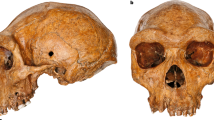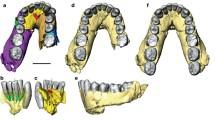Abstract
THIS communication was stimulated by a recent comment by Wolpoff1. Results of my researches2–4 on the human fossils recovered from the Mindelian site at Vértesszöllös in Hungary may be summarized as follows. Vértesszöllös man is related by origin to forms such as Pithecanthropus, Sinanthropus, Atlanthropus; he represents an evolved variety of this group (“archanthropic man”), and is probably ancestral to some early progressive forms of Pleistocene man, best represented by the Swanscombe skull. For sake of identification and priority I named Vértesszöllös man Homo (erectus seu sapiens) palaeohungaricus. Some workers5,6 consider archanthropic man as a conventional grade in the evolution of H. sapiens; others reserve for him a separate palaeospecies, H. erectus. Once the clade and grade have been determined, however, the name does not change the phyletic position of the fossil.
Similar content being viewed by others
References
Wolpoff, M. H., Nature, 232, 567 (1971).
Thoma, A., L'Anthropologie, 70, 496 (1966).
Thoma, A., Z. Morph. Anthrop., 58, 152 (1967).
Thoma, A., Z. Morph. Anthrop., 60, 229 (1969).
Robinson, J. T., Evol. Biol., 1, 69 (1967).
Thoma, A., Homo, 21, 54 (1970).
Author information
Authors and Affiliations
Rights and permissions
About this article
Cite this article
THOMA, A. On Vértesszöllös Man. Nature 236, 464–465 (1972). https://doi.org/10.1038/236464a0
Received:
Issue Date:
DOI: https://doi.org/10.1038/236464a0
- Springer Nature Limited





